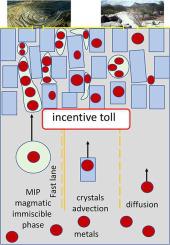当前位置:
X-MOL 学术
›
Ore Geol. Rev.
›
论文详情
Our official English website, www.x-mol.net, welcomes your
feedback! (Note: you will need to create a separate account there.)
Toward a global conceptual model for metal enrichment in felsic, mafic-ultramafic, and alkaline-carbonatitic magmas
Ore Geology Reviews ( IF 3.2 ) Pub Date : 2021-02-01 , DOI: 10.1016/j.oregeorev.2020.103925 Jean-Louis Vigneresse , Christophe Ballouard , Xuan Liu , Antonin Richard
Ore Geology Reviews ( IF 3.2 ) Pub Date : 2021-02-01 , DOI: 10.1016/j.oregeorev.2020.103925 Jean-Louis Vigneresse , Christophe Ballouard , Xuan Liu , Antonin Richard

|
Abstract The formation of intrusion-related metal ore deposits commences with a combination of sequential metal and melt interactions in the magma reservoir: (i) metal diffusion within the melt; (ii) melt motion; (iii) metal partitioning between silicate melts and a magmatic immiscible phase (MIP, including immiscible melts and/or immiscible vapor phases, and crystalized solids; (iv) metal advection in the melt; (v) chemical interactions between the MIP and the mush; and (vi) finally metal deposition. Occasionally, these processes may also develop simultaneously, and lead to formation of multiple depositional centers. During those events, the presence of the MIP seems preponderant and a prerequisite to metal segregation and transport with the interactive mush. Based on forward and inverse modeling, novel diffusion-partitioning-advection models are proposed to account for economic metal enrichment (three to five orders of magnitude relative to initial concentrations in parental melts). For felsic to intermediate magmas, metals (Cu, Mo, W, Sn) are enriched in a saline aqueous phase by diffusion and metal partitioning. Progressive stagnation of melt motion enhances metal diffusion according to the tortuosity of a developing mush and destabilization of plagioclases. The metal-rich liquids separate from the magma reservoir by advection and transfer the metals to the country rocks. For mafic/ultramafic magmas, the MIP is a dense, sulfide melt, which preferentially sequesters metals (Ni, Cu, platinum group elements). The sulfide droplets interact with olivine to scavenge more Ni before they sink toward the bottom of the magma chamber due to negative buoyance. The down-going flow may even become turbulent according to the melt viscosity, leading to disperse and chaotic ore. In peralkaline magmas, CO2-rich carbonatitic melts are the MIPs formed by segregation of CO2-poor feldspathoid syenite melts, and attracting rare earth elements. Those are selectively partitioned by fenitization. In all the three different types of magmatic system, metals diffuse from viscous evolved parental melts toward a MIP, which is responsible for metal partitioning, segregation and transports. This global conceptual model for metal enrichment focuses on the competition between metal diffusion within the melt, melt viscosity and metal partitioning between the parental melt and MIP. However, a second stage of metal enrichment occurs during interaction of the already enriched melt and the mush. Such conceptual model is a first order model that could suggests newer ideas to ore formation.
中文翻译:

迈向长英质、镁铁质-超镁质和碱性-碳酸质岩浆中金属富集的全球概念模型
摘要 与侵入相关的金属矿床的形成始于岩浆储层中连续金属和熔体相互作用的组合:(i) 熔体中的金属扩散;(ii) 熔体运动;(iii) 硅酸盐熔体和岩浆不混溶相(MIP,包括不混溶熔体和/或不混溶气相和结晶固体)之间的金属分配;(iv) 熔体中的金属平流;(v) MIP 和糊状物之间的化学相互作用; 和 (vi) 最后金属沉积。有时,这些过程也可能同时发展,并导致形成多个沉积中心。在这些事件中,MIP 的存在似乎占主导地位,并且是金属分离和传输的先决条件与相互作用的糊状物. 基于正向和逆向建模,提出了新的扩散-分配-平流模型来解释经济的金属富集(相对于母体熔体中的初始浓度三到五个数量级)。对于长英质到中间岩浆,金属(Cu、Mo、W、Sn)通过扩散和金属分配在盐水相中富集。根据发展中的糊状物的曲折和斜长石的不稳定,熔体运动的逐渐停滞增强了金属扩散。富含金属的液体通过平流从岩浆库中分离出来,并将金属转移到围岩中。对于镁铁质/超镁铁质岩浆,MIP 是致密的硫化物熔体,优先螯合金属(Ni、Cu、铂族元素)。硫化物液滴与橄榄石相互作用以清除更多的镍,然后由于负浮力而下沉到岩浆房底部。根据熔体粘度,下行流甚至可能变得湍流,导致矿石分散和混乱。在过碱性岩浆中,富含 CO2 的碳酸岩熔体是通过偏析缺乏 CO2 的长石样正长岩熔体并吸引稀土元素而形成的 MIP。那些通过非尼化有选择地划分。在所有三种不同类型的岩浆系统中,金属从粘性演化的母体熔体向 MIP 扩散,MIP 负责金属的分配、分离和运输。这种金属富集的全球概念模型侧重于熔体中金属扩散、熔体粘度和母体熔体与 MIP 之间的金属分配之间的竞争。然而,金属富集的第二阶段发生在已经富集的熔体和糊状物的相互作用过程中。这种概念模型是一阶模型,可以为矿石形成提出新的想法。
更新日期:2021-02-01
中文翻译:

迈向长英质、镁铁质-超镁质和碱性-碳酸质岩浆中金属富集的全球概念模型
摘要 与侵入相关的金属矿床的形成始于岩浆储层中连续金属和熔体相互作用的组合:(i) 熔体中的金属扩散;(ii) 熔体运动;(iii) 硅酸盐熔体和岩浆不混溶相(MIP,包括不混溶熔体和/或不混溶气相和结晶固体)之间的金属分配;(iv) 熔体中的金属平流;(v) MIP 和糊状物之间的化学相互作用; 和 (vi) 最后金属沉积。有时,这些过程也可能同时发展,并导致形成多个沉积中心。在这些事件中,MIP 的存在似乎占主导地位,并且是金属分离和传输的先决条件与相互作用的糊状物. 基于正向和逆向建模,提出了新的扩散-分配-平流模型来解释经济的金属富集(相对于母体熔体中的初始浓度三到五个数量级)。对于长英质到中间岩浆,金属(Cu、Mo、W、Sn)通过扩散和金属分配在盐水相中富集。根据发展中的糊状物的曲折和斜长石的不稳定,熔体运动的逐渐停滞增强了金属扩散。富含金属的液体通过平流从岩浆库中分离出来,并将金属转移到围岩中。对于镁铁质/超镁铁质岩浆,MIP 是致密的硫化物熔体,优先螯合金属(Ni、Cu、铂族元素)。硫化物液滴与橄榄石相互作用以清除更多的镍,然后由于负浮力而下沉到岩浆房底部。根据熔体粘度,下行流甚至可能变得湍流,导致矿石分散和混乱。在过碱性岩浆中,富含 CO2 的碳酸岩熔体是通过偏析缺乏 CO2 的长石样正长岩熔体并吸引稀土元素而形成的 MIP。那些通过非尼化有选择地划分。在所有三种不同类型的岩浆系统中,金属从粘性演化的母体熔体向 MIP 扩散,MIP 负责金属的分配、分离和运输。这种金属富集的全球概念模型侧重于熔体中金属扩散、熔体粘度和母体熔体与 MIP 之间的金属分配之间的竞争。然而,金属富集的第二阶段发生在已经富集的熔体和糊状物的相互作用过程中。这种概念模型是一阶模型,可以为矿石形成提出新的想法。











































 京公网安备 11010802027423号
京公网安备 11010802027423号